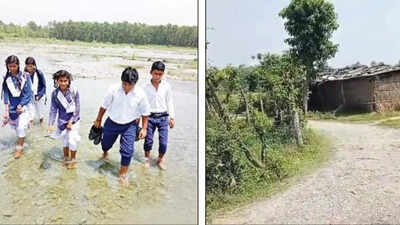ARTICLE AD BOX

DEHRADUN/NAINITAL: As monsoon rains sweep across Uttarakhand painting the hills lush green, a little-known tiny village, Khuriakhatta, in Nainital district lies surrounded by water from all sides due to which it becomes difficult for villagers to leave the area during the monsoon months, making them virtually prisoners in their own village.
The village is popularly referred to as 'Sri Lanka tapu (island)' since it's shape resembles the island nation when seen from an aircraft.The geographical story for the village started in 1984, when the Gaula river that originally flowed from the east, underwent a significant change in its course following floods, and began flowing toward the west. This dramatic shift in direction marked a transformation in the region's natural landscape with Khuriakhatta witnessing the most notable change.
Located around 20 km away from Haldwani city in Lalkuan area, the hamlet of around 115 families transforms into a seasonal island every year.
Spanning around 45 hectares, the village is flanked by the surging Gaula river on one side and dense forest by two others, leaving just a pathway on the remaining direction to access the village. In monsoon, the forest and pathway also get submerged, virtually trapping the villagers for around three months.
The name 'Sri Lanka Tapu' was coined in 1984 when severe floodings prompted mediapersons flying over the area to compare its shape to the island nation of Sri Lanka. Since then, the name stuck, overshadowing the village's original identity of Khuriakhatta so much so that even on many govt documents, it is mentioned as 'Sri Lanka Tapu'.Before the onset of monsoon, the district administration tries to ensure all preparations to meet any contingency.
For instance, this year, it has already delivered three months worth of rations and basic medicines to villagers. But for residents, the rainy season brings more than just isolation - it resurfaces long-standing issues of neglect.Despite being a short distance from urban centres, the village remains completely off the power grid. "Electricity is not a big demand in today's modern age. Even the most remote hill villages in the state have it.
So, why not us?" said Dharam Singh Koranga, a resident.Since 1984 floods, the village has never been electrified. Solar panels, distributed years ago during an earlier govt, serve as makeshift sources of light - with only three bulbs per household. However, most of the panels are now defunct.Apart from electrification, the village also suffered a major blow in 2011 when the only govt primary school was swept away. "It was never rebuilt, and no official paperwork has been processed.
Young children who attend the anganwadi centre, remain at home during the three months of monsoon while older students rent rooms or live with relatives in Bindukhatta area, 45-km away from 'Sri Lanka Tapu', to attend school or college," added Koranga.It is not only the geographical change that is the cause of concern here, but the river's strong currents are also eroding the surrounding land of 'Sri Lanka Tapu'. Locals claim that the area under cultivation and habitation is "gradually shrinking".
Demands for constructing embankments to protect the village from erosion, seemed to have fallen on deaf ears."Before 2015, during the Congress-led govt, some embankments were built. But nothing happened after that. Even the ones that were washed away 10 years ago, have not been repaired," said another villager, Kamlesh Kumar, adding, "Repeated requests for electricity and embankments have yielded only assurance, nothing else."
There is also lack of proper health facilities in the remote village as locals travel to Bindukhatta to avail basic medical care.
"A few months' supply of medicines, left behind in the anganwadi by officials each June, often goes unused. During emergencies, patients - including pregnant women - are carried across forest trails and flooded streams to reach healthcare centres in Kiccha or Shakti Farm area several kms away," added Kumar.Meanwhile, ADM of Haldwani, Vivek Rai, told TOI that local administration takes all the necessary steps before the advent of monsoon. "The actions include making a temporary helipad to facilitate any emergency evacuation or providing rations when needed. A team of local officials visit the village before monsoon to assure them of all possible help... The situation has never gone out of control."Regarding basic infrastructure like school, hospital and power supply, he said that a part of the village falls under the forest department, which is why these services could not be extended.
"We're in touch with them to find a solution."The residents, primarily dependent on farming and dairy, cultivate crops like poplar, paddy, sugarcane and wheat. However, frequent land erosion and unpredictable weather conditions threaten their fragile livelihoods too. "It seems development never received the address of our village," a local farmer lamented. "Is it too much to ask for a life with dignity? How long can we survive on solar lights, broken paths and forgotten promises?"



.png)
.png)
.png)
















 19 hours ago
2
19 hours ago
2









 English (US) ·
English (US) ·